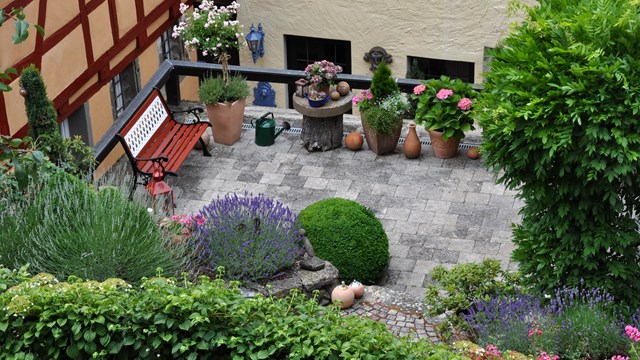
New York City is known for many things beautiful—architecture, a rainbow of diverse cultures, and its fabulous skyline, but let's face it, outside of Central and Prospect Parks, most people aren't aware of how much park land actually exists in the city.
Well, how green is New York City and its five boroughs? You might be surprised to find out that, according to the New York City Department of Parks & Recreation, there are more than 1,700 parks citywide encompassing around 28,000 acres. Park properties range from swimming pools and skating rinks to gardens, nature trails, wetlands and woodlands.
And adding to this mix, some co-op and condo buildings have been working hard to integrate some greenery into the overall rather monochromatic exterior by converting unused areas such as rooftops, courtyards, alleyways and empty lots into strikingly lush community gardens.
There are already many rooftop gardens on commercial buildings (Rockefeller Center, for one) and community gardens throughout the city, including one at 6th Street and Avenue B in the East Village, and the West Side Community Garden on West 89th Street.
Residents are reaping the environmental, cultural, social and psychological benefits of these gardens. "Studies show that being close to plants in general will elevate moods and increase productivity," says Julie Bawden Davis, author of Indoor Gardening the Organic Way. "Plants also give us oxygen, and they are the only thing on the planet that filter and get rid of CO2. Cities are also trying to lower the temperature and put in green spaces. Plus, the prettier the environment, the more the people would want to live there."
Looking after many of these urban gardens are the Green Guerillas—a group founded in 1973 by Liz Christy, a Lower East Side artist who gathered her friends and neighbors together to clean out a vacant lot on the corner of Bowery and Houston Streets. Since then, the advocacy group has taken on many gardening projects in and around New York City, inspiring and helping people to cultivate community gardens and preserve precious green spaces.
Legendary entertainer and Manhattan resident Bette Midler has even been involved in greening the Big Apple, founding the non-profit New York Restoration Project in 1995, with the belief that clean and green neighborhoods are fundamental to the quality of life.
A Garden that Fits
A garden is a beneficial addition to any space, but what kind of garden you create depends on a variety of factors, including budget, technical considerations including drainage and maintenance, space and what the area will be used for. Will residents sit and congregate there for relaxing and socializing? Will they pick vegetables, or just smell the flowers?
How can your condo or co-op utilize its space to plant the seeds of an urban garden? According to Bawden Davis, the actual space will dictate what you will and won't be able to do.
"What you build depends on whether you are using a vacant space next to a building, usable space on the rooftop, usable ground floor space or even the resident's balconies and patios for window boxes," she says. For example, a more grandiose landscape might be suitable for an empty lot, but may not be suitable for a small rooftop. Roofs that are older and cannot bear much weight may not even be suitable for a garden and the building might need to consider window boxes or a ground floor garden instead.
What you build also depends on how much money is in the kitty. Just like ordering a ton of food when you're starving only to find you can't finish it all, it's just as important to think within your means when it comes to an urban garden.
"The cost depends on what you want—plants and a bench, or a whole water wall and hardscape," says William Vecchione, president of B&G Landscape Architects, LLC in Clark, New Jersey. "An outdoor space can cost from $15,000 to $100,000, and even $200,000, especially if the garden needs draining and structural engineering."
So if the board dreams about a lavish garden, equipped with waterfalls, elegant outdoor furniture, expensive flowers, a vegetable garden and more, but the size of the space or the limitations on budget only allows for a few chairs and a few plants, you'll have to make some compromises.
Bawden Davis says it's important to consider what kind of landscape you want before you embark on a landscaping endeavor. "Do you want edible crops; perhaps a bunch of containers with edible dwarf fruit trees or strawberries?" she says. "The maintenance on them is that you just need to feed, water and harvest when the fruit comes in. Or, you can create smaller 'railroad' gardening landscapes," narrow strips of green plants and flowers.
Roof Gardening 101
Building any urban garden, but especially a rooftop garden, requires many different considerations, so it's important to work with a professional landscape architect at the planning stage who can guide the process. The architect will visit the site, examine the roof's age and condition and consider budget and wishes. If the board has appointed a design committee, the professional will then coordinate with the committee and develop an approved plan to be presented to the board.
"We'll also talk about whether or not there are any planned repairs or upgrades to the roof," says Kim Mathews, principal of Mathews Nielsen Landscape Architects in Manhattan. "We also ask if the garden will affect a warranty if it was recently upgraded or repaired."
A roof garden is an exciting way to create beauty in an unused space, but there are several technicalities to consider with this option. Firstly, it's important to understand the permit process for rooftop gardens.
"You need to have a building permit and it probably needs to be zoned," says Vecchione.
While theoretically any roof surface can be greened—even sloped or curved roofs can support a layer of sod or wildflowers—it's important to use lightweight and recycled materials, soil that doesn't exert pressure on the building and plants that won't root through the roof and harm it. Most importantly, since there is no such thing as a maintenance-free roof garden, there must be a method of storm water management to drain excess water from the roof, or add water during a dry spell, so it can be built right into the design.
"If the building isn't designed with a drainage system, one needs to be built in and that's where much of the budget goes to," says Vecchione. "We will raise everything on a roof membrane, so there is no leakage. How we do that depends on the weight that the roof can bear and what stone can be used."
According to Madelyn Simon of Madelyn Simon & Associates, a division of Blondies Treehouse, Inc., in New York City, "most roofs are designed for 40 pounds per square feet [but this can vary depending on the roof.] One could do fiberglass or plastic planters, wood or anything lightweight," says Simon. "Also, for most roof gardens, you wouldn't put it directly on the roofing surface, or [root systems] could pierce the roof. You would build a frame and it's removable, in case you have to uncover the roof it's easy to do."
Wind is the next safety issue to consider, and the installation of a parapet wall is a must. A parapet wall is built entirely above the roofline and prevents items from blowing over.
"You also have to make sure certain items—like small trees or anything else more than a couple of feet tall—are staked with cables," says Vecchione.
A Garden On its Way
Once the safety issues are considered, you can add extras into the package.
If the residents will utilize the garden, especially at night, outdoor lighting is a must. "Most of us work during the day and want to utilize the space at night and the lighting makes it more usable," says Simon. "We have one client who even has hammocks on the roof in the shade."
With New York enjoying the warmer weather, it might seem ideal to start this project now, but Mathews says that it's already too late for this spring and board's should consider starting the project now so it can be ready in the fall or at this time next year.
"It's very important to get your planning and ordering all figured out in the off season, because planting seasons are generally now until early June and then again mid-September to Thanksgiving," says Mathews. "Start planning to hire a firm in the summer, work with them in the summer and fall, and put the documents out to bid in the winter so the contractor can start in the early spring."
Of course, the timing for the green space also all depends on the speed of the decision-making process of the board. Nothing can be done before approval is solidified and there is an overall agreement about the need for a garden.
Neighbors of all ages gather at the gardens, enjoy community events and contribute to protecting New York City's environment. They are also finding out that Kermit the Frog was wrong—it is easy being green—with a little work. So if your building could benefit from a shot of shrubbery, an urban garden might be an ideal solution.
Lisa Iannucci is a freelance writer living in Poughkeepsie, N.Y. and a frequent contributor to The Cooperator.






4 Comments
Leave a Comment